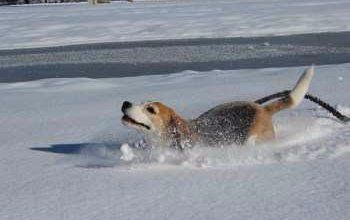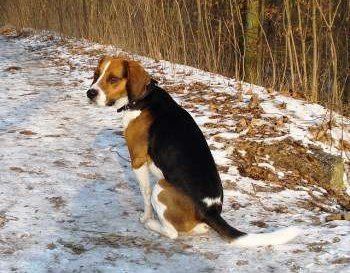Winter Care
Beagle Winter Care

Overview
Any owner who lives in a region that experiences cold weather will wonder if a Beagle needs any special care in the winter.
After all, this is a hound dog with a colorful history of hunting outdoors and spending countless hours tramping through the fields. So, does a Beagle need to be winterized?
The answer may surprise you and it will certainly help your puppy or dog stay more comfortable and healthy during the cold winter months.
Winter brings much drier air than other seasons and of course, cold temperatures. These two elements can have an effect on a Beagle's:

After all, this is a hound dog with a colorful history of hunting outdoors and spending countless hours tramping through the fields. So, does a Beagle need to be winterized?
The answer may surprise you and it will certainly help your puppy or dog stay more comfortable and healthy during the cold winter months.
Winter brings much drier air than other seasons and of course, cold temperatures. These two elements can have an effect on a Beagle's:
• Paws
• Nose
• Skin
• Coat
• Rate of shedding
• Appetite
• Ability to control body temperature
In this section, we are going to discuss:
• Preventative care to protect certain areas of the body
• Changes to expect in regard to grooming and eating
• How long a Beagle can safely be outside in the winter
What Winter Air Can Do
Even when it snows, the humidity during the winter is generally much lower than any other time of the year. This applies to both outside and inside air. While one day of exposure to dry air would have very little effects on a Beagle, several months can cause a drying of the paws, nose and skin.
The Paws
What happens -
A Beagle's paws take a beating in the winter. Not only do the leather paw pads dry out due to the arid air, walking on winter surfaces has quite an effect as well. One of the biggest culprits is ice melt chemicals.
Even if you do not use these on your own walkway and/or driveway, they are often brought in by vehicles that have traveled on town and city roadways.
When a Beagle is taken for walks, his paws may receive a gradual chemical burn due to these substances.
In addition, many towns sand the roads which are another element that can be tracked onto the route that you walk your Beagle. These tiny pebbles - over time - can aggravate the pads.
What to do -
It's best to be proactive before any issues start and a good way to do that is to protect the paws with canine paw wax. It adds a layer of protection from ice, salt and other outdoor elements while maintaining good traction. It is commonly used for hunting and mushing; though applying some to a pet Beagle before heading outside in the winter can keep the paws healthy during the cold spells.
Best are products that are 100% waxed based creams that contain vitamin E. You'll want to apply it to not only the pads but also between a Beagle's toes. Quality products dry almost instantly, making them easy to use. Quality balms will be semi- permeable and therefore will only need to be applied about once per week.
The Nose
What happens -
The drying effects of both wind and cold will chap a Beagle's nose; especially if the puppy or dog tends to lick his nose…and most do. Slight nose chapping will cause slight tingling or itchiness that increases when outside. In response, the Beagle will lick which only causes the nose to chap even more.
This not only causing chapping in the winter, but if it is left untreated it can lead to quite severe cracking and then be vulnerable to infection. See also: Beagle Dry, Peeling Nose.
What to do -
You'll want to use a canine nose balm to protect the nose leather as part of the winter care for your Beagle. These products are sometimes referred to as snout butters or creams. These will prevent problems as well as treat existing issues with cracking. It is recommended to use an organic balm that is fragrance free.
You'll want to dab this over the nose before heading outside and for any issues with cracking, applying some 2 to 3 times a day will help to heal a dry, winter nose.
The Skin and Coat
What happens -
Winter can be rough on a Beagle's coat and part of a good plan for winter care is to be proactive in keeping the coat healthy during cold weather. Just as with the above problems, this mostly comes down to dry air. When skin loses moisture, it will have an effect on the dog's coat as well.
Dry skin will result in itchiness that can lead to thinning coat issues. In addition, static in the wintertime can cause some breakage that leads to fur loss. If you notice that your Beagle scratches more in the winter or his coat looks dull and dry, you can blame Old Man Winter.
What to do -
Many owners tend to limit baths in the winter, since too many baths can lead to dry skin. However, this can lead to even more problems because decreasing baths means that you will not be able to apply the proper products to the body. For this reason, in the winter it is suggested to stay on schedule in regard to baths and if you do notice problems, increase baths.
You'll want to use a rich, thick, moisturizing shampoo or treatment that will infuse the skin and fur with moisture. Be sure to follow this with both a rinse-out conditioner and a leave-in conditioner. When you use the leave-in product, you will be protecting the hair shafts from the cold, the static and the arid air.
This is best applied with a mist to the roots while brushing to distribute it over the coat. Don't forget the tail and legs of your Beagle; two areas that are often not given much attention but do need winter care protection.
Wintertime Changes in Appetite
It's quite normal for a Beagle to eat more in the winter. In fact studies show that the appetite of dogs fluctuates throughout year. They eat the least from June to August and the most from November to February.
Due to seasonal triggers coupled with a need for more calories to regulate body temperature, a Beagle may require up to 15% more food during the winter. Note that older, senior dogs and those that are not brought outside very much may not have an increased appetite.
If you do notice that your Beagle seems hungrier in the winter, you won't necessarily need to add an extra meal; a healthy option is to add some wholesome ingredients such fruit
(blueberries, raspberries, etc.) and some vegetables (carrots, sweet potato) to meals.
This can give a Beagle more calories during the winter while keeping things healthy to prevent unwanted weight gain.


Shedding Issues
Beagles will shed more as winter approaches. This is because the lighter 'summer' coat is falling out in preparation for a slightly heavier winter coat. It is not the cold temperature that triggers this to happen; it is the shortened days of available sunlight. Therefore, even if you are having a mild winter, the shorter days will cause a Beagle to shed in the late fall.
This, combined with possible thinning issues due to drying skin and/or static breaks, will require owners to brush and groom
more to keep up with a transitioning coat. A good amount of the short hairs of a Beagle will fall back into the coat, causing a blockage of healthy air flow to the skin.
You'll want to control this winter prep shedding
by thoroughly brushing the entire body on a regular basis. If the air in your home is very dry, it can help to first mist the coat with a light leave-in spray to prevent breakage that can occur from brushing a dry coat.
How Long a Beagle Can Stay Outside in the Winter
While the Beagle is a fantastic hunting and scent tracking hound, he traditionally laid at his owner's feet in front of a massive fireplace after trudging through snow covered fields. While some were/are kept in outdoor kennels, in today's modern world, this breed is rarely a full time outdoor dog. A Beagle will adapt and acclimate himself to the environment that he is exposed to. Therefore, for a Beagle would need to be raised and trained to be an outdoor dog in order to handle cold winter temperatures.
A typical pet Beagle will be just fine when taken outside to play in the snow and to go for walks, however he is vulnerable to the effects of the cold and able to develop hypothermia and frostbite as much as any other dog that is used to sleeping in a warm house.
On days that are above 32 degrees Fahrenheit (0 C) you can bring your Beagle outside for the same amount of time as usual. In fact, many owners need to consciously make an effort to maintain this routine since it is usually the owner who gets cold and wants to run inside before the dog does.
If exercise
time is reduced during the winter, a Beagle can act out due to unreleased pent up energy which can lead to increased barking and howling and even destructive chewing. In addition, not walking as much as usual may result in unhealthy weight gain. For this reason, owners are encouraged to bundle up, put paw and nose balm on their Beagle and head outside.
On days that are below freezing (keeping in mind the wind chill factor as well) or during any winter storms, you'll want to limit outdoor exposure to 20 minutes. Once temperatures plummet to below 32 degrees (0 Celsius) a dog will expend energy to control body temperature. This puts stress on the whole body, including the heart. Exposure can lead to hypothermia and in some cases, frostbite.
Severe icing or blizzard-like conditions are certainly a valid reason to stay inside.
A Word About Senior Beagles in the Winter
Winter care for older,
senior Beagles should include reevaluation of arthritis related issues. Many older dogs suffer from sore joints that flare up during the winter. This is a good time to check to see if your dog's orthopedic bed needs replacing and to make sure that his/her resting area is not subject to drafts. Any noticeable changes in mobility should be brought to the attention of the veterinarian.
Summary
Some of us love winter and others start praying for spring the moment that the days become shorter. What do our Beagles think? Well, it's safe to say that how we care for our dogs can have an effect on how much they enjoy the seasonal changes.
Protect the paws and nose, keep the skin and coat healthy, provide extra calories in the form of healthy meal additions and keep your Beagle's exercise as regular as possible. Following these care guidelines can help ensure that wintertime is a comfortable and healthy time for your Beagle.
You may also like:
Beagle puppy care
- A helpful overview of the necessary care elements for young Beagle puppies.
Beagle digging
- Why some Beagles just love to dig and steps you can take to prevent your yard from looking like a gopher field.
Beagle life span
- How long this breed lives on average, leading causes of death & ways to help your dog live a long life.
Beagle runs away
- Why a dog is prompted to try and escape, what to do to prevent this & how to react if the dog is successful.
Share Us
Share
Tweet
Share
Mail
All text and photographs protected by US and International copyright laws.
Copyright. BeaglePro.com
We are a participant in the Amazon Services LLC Associates Program, an affiliate advertising program designed to provide a means for us to earn fees by linking to Amazon.com and affiliated sites.


